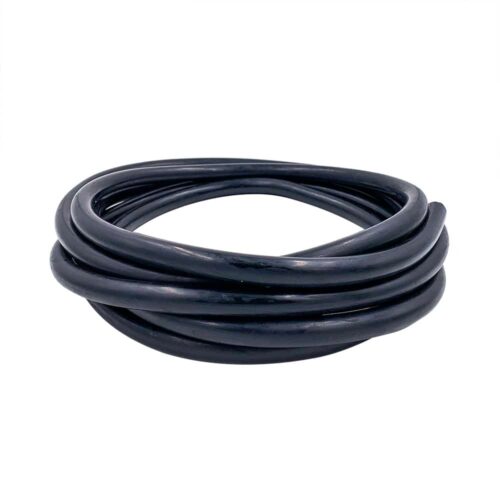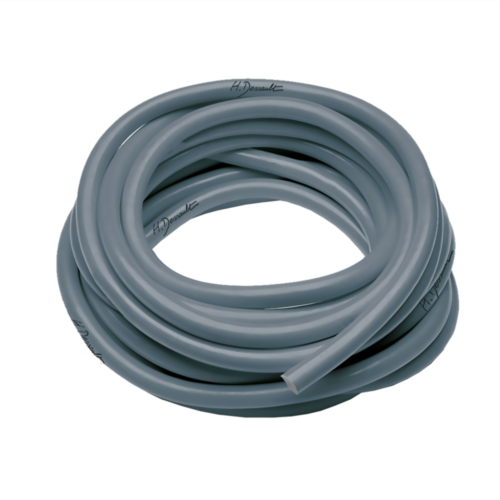Choosing the right speargun rubber bands can mean the difference between an accurate shot and an unsatisfactory result. Choosing the right rubber is critical to ensuring the right power for your speargun or roller.
Gli elastici destinati alla pesca subacquea sono tutti prodotti in Latex, “lattice naturale” o “gomma naturale”. Il lattice naturale è estratto dal lattice del caucciù, che è il succo lattiginoso ottenuto dall’albero della gomma (Hevea brasiliensis).
In this comprehensive guide we will provide you with everything you need to know about elastic rifle tires. We will look at the different manufacturing processes and the characteristics of the various products available on the market. We will see what the elongation factors are and how to calculate the cut length of the rubbers sold "by the meter" for setting up your rifle. We will also give you practical advice on how to maintain them to optimize their durability and performance.
LATEX COMPOUND (VARIABILITY)
Latex used in the production of rubber for rubber band rifles can derive from different geographical sources, such as Asia, Africa or South America, characterizing it as a natural material subject to variability according to'origin. This variability is not exclusively related to geographic region, but also extends among plants within'the same area. This makes latex a product that is never totally the same, like wine.
Once extracted, the latex is distributed to processors in different parts of the world, including America, Europe and Asia. Each company adopts customized formulas, although the term "natural latex" is common, each company develops a compound that includes various additives designed to give the latex the specific properties required for different applications, including spearfishing.
PRODUCTION PROCESSES (EXTRUSION - IMMERSION)
There are two industrial processes for the production of rubbers intended for elastic rifle outfitting: extrusion and immersion.
Extrusion
In the extrusion process, the company's prepared compound of viscous consistency is extruded through a die of the desired diameter and transported to the first drying oven. Immediately afterwards, it is sectioned and then placed in vulcanization ovens where the process ends with the consolidation of the finished product. The'elastic produced by this process is formulated from a single compound and is therefore uniform with a single coloration.
Immersion (dipping process)
In the immersion process, the compound prepared by the company lies in immersion tanks, called baths, which may contain different compounds or colorings as needed.
In this process, a wire backing is repeatedly dipped into tanks, alternating the process with drying steps in special ovens. Each immersion adds a layer of latex, thus increasing the diameter of the elastic. When the desired diameter is reached, the'elastic is sectioned into skeins and goes through an oven curing process from which the finished product emerges.
It is popular in the construction of arbalete elastics to run the last few baths in a different color compound, so the finished rubber will have an outer layer of a different color than the bulk of the rubber.
The'elastic produced by this process can consist of different compounds and can therefore have layers with different characteristics or coloration.
THE COMPOUNDS OF ELASTIC BANDS
The composition of the latex compound is usually a trade secret of the manufacturing company. There are more reactive compounds and more progressive compounds.
Compounds defined as reactive usually have higher rubber shore hardness and higher springback, while progressive compounds are characterized by lower shore hardness and lower springback.
It is important to specify, however, that rubber springback is not always directly proportional to shore hardness, but is also a function of the intrinsic characteristics of the compound.
Reactive Elastics
The higher shore hardness of the rubber leads to a higher load, at the same percent elongation, and consequently a "meaner" pull. These compounds are called reactive.
Progressive Elastics
The lower shore hardness of the rubber leads to a lower load, at the same percent elongation, and consequently to a "softer" and less powerful pull. These compounds are called progressive.
Today, in 90% of cases, medium compounds are preferred, that is, high-quality compounds that manage to combine progression and responsiveness, with excellent springback. These rubbers, if well sized with the mass of the rod and rifle, are the ones that will be able to express more velocity at the rod, while ensuring a stable and accurate shot. Very reactive compounds are avoided, which often lead to abrupt and less accurate shots, or very progressive compounds, which impart a few pounds of thrust to the rod, resulting in the need to use more rubbers, or to use larger diameter rubbers, unnecessarily increasing the overall dimensions.
CONFIGURATION OF ELASTIC BANDS
Arbalete rifles adopt two possible rubber band configurations. A rifle can be set up for the use of "in-line" rubber bands, or "circular" rubber bands.
In some cases, it is possible for the head of an arbalete to have the option of using both types of elastic, so there will be a housing for the inline elastic and a housing for the circular elastic. Let's look in detail at the differences between circular and inline elastic.
Elastic In Line
In-line elastic is composed of two pieces of elastic of identical length, which are tied at one end to the rifle head and at the other end are tied to the nosepiece.
This configuration is most common in low-to-medium range crossbows equipped with a threaded ferrule head, in a single-elastic mouthpiece version.
Circular Elastic
The circular rubber band consists of a single piece of rubber that closes circularly on the nosepiece. This circular rubber band is passed through a dedicated hole in the rifle head.
This configuration is increasingly common in crossbows of all ranges and in multi-rubber configurations because of its versatility and ease of use/replacement. Circular rubber bands are now increasingly rare in the mouthpiece version; they are, however, very common in the meter version with bindings.
RUBBER BANDS FED VS. RUBBER BANDS BY THE METRE
There are basically two types of elastic bands for arbalete, mouthpieces and "meter" bands. Let's see what the differences are.
Elastics Looped
These rubber bands are pre-cut and equipped with threaded bushings (M16) at the ends. They are intended for use on arbalete equipped with a threaded ferrule head. The elastic band screws onto the rifle head on one end and onto an ogive with threaded ferrules on the other.
These rubber bands should be bought already made to size for your rifle and are available in different diameters.
The trend today is to mount rubber bands by the meter because they are more versatile and hydrodynamic, so fewer and fewer companies are investing in this product and consequently we have a smaller choice of compounds. However, we do have one company in particular that offers a very high quality rubber band in the bushing version. We will look at that later.
Elastics by the meter
Elastics sold by the meter are undoubtedly the most popular and best-selling ones in recent years, this is due to the flexibility, versatility and hydrodynamics of the bound elastic.
Elastic metre bands, unlike those that are screwed on, must perforce be tied on the nosepiece (and in some cases at the head) to form the elastic that will be mounted on the head of the arbalete. This type of elastic is also the one most suitable for setting up roller guns.
The advantages of elastic meter bands are:
- Lower cost for the same length.
- Wide choice of compounds and quality.
- High hydrodynamics due to smaller ligature footprint.
- User-determinable percentage of elongation.
- More performance.
The disadvantages of meter rubber bands are:
- They are not ready to use.
- They must be tied by the user or manufacturer.
- If manual skills are lacking, ligatures must be done by a specialized center, at an additional cost.
Later we will see what are some of the best meter rubber bands on the market.
DIAMETER OF RUBBER BANDS
The most commonly used diameters for rubber band rifle tires are: 14, 15, 16, 17, 18 and 19 mm. In this case, the outer diameter is mentioned.
The diameter of the inner hole in the tires can be standard type (about 3.2 mm) or "small" type, also called "Small ID" (about 1.6 mm).
The outer diameter, together with the type of compound, determines the load of the rubber band at a given elongation factor. For the same percentage elongation, as the diameter increases, the tire load increases.
Therefore, for the same length, it will be more difficult to hook a 19-mm rubber band on the rod fin than a 14-mm rubber band.
The small hole compared to the standard hole allows more rubber for the same outer diameter, which means more load and performance. However, this greater amount of rubber is on the order of very few percentage points, and is therefore more appreciable in elastics with smaller diameters, between 14 and 16 mm.
Elastics with a small hole, however, have a disadvantage: the small hole size makes the insertion of the ogive more complex and laborious. They are therefore unsuitable for beginners who do not have much experience with tying rubber bands.
ELONGATION FACTORS AND CALCULATION
To optimize the power and accuracy of your rifle, it is important to use proper percentage elongation of the tires. In this section we will only give basics, further insights can be requested from our customer care.
Rubber tires, regardless of diameter, are made to work with elongations between 300% and 400%. The greater the elongation factor and the larger the tire diameter, the greater the load (pounds of thrust) produced by the tires.
The ideal elongation percentage is a function of many factors, such as the mass of the rod, the amount and diameter of the tires used, their compound, the mass of the rifle, etc. We will not cover this topic in this paragraph because it is too full of variables, but you can always contact our customer care for free advice.
Once you have chosen the diameter of the rubber, the type and the percentage of elongation you want to work with, calculating the cut length of the rubber band is super simple. There are many mathematical formulas on the web, but we prefer to express the concept to you first.
Imagine you have your rifle loaded with a circular rubber band; measure the length of the'elastic under tension, starting from one binding to the other. The length you find corresponds to the portion of the elastic that is actually working. Now simply divide this length by your chosen stretch factor (example: if your chosen stretch factor is 350%, then you must divide by 3.5). The result you will get will be the length of the elastic at rest, to which you will only need to add a few centimeters to make the ligatures (example: add 3 cm. 1.5 cm per ligature). This is the length to which you will need to cut the rubber to make up your circular rubber band.
TIRE MAINTENANCE
It is important to note that natural latex can deteriorate over time due to'exposure to weather, sunlight and stress from use. It is therefore advisable to replace rubber bands whenever they show obvious signs of wear to ensure optimal performance and safety during'use.
Below are some tips on how to take care of your tires.
Regular cleaning
After each shooting session, it is important to rinse the tires with fresh water to remove any salt residue or dirt. Avoid using harsh cleaners or chemicals that could damage the material.
UV protection
Rubber bands are sensitive to UV rays and to'prolonged exposure to the sun. To prevent them from deteriorating prematurely, be sure to store your rubber bands in a cool, dry place out of direct sunlight. When at sea, if possible, use a case or bag to protect the rubber bands mounted on your rifles.
Lubrication
This is a step that few people know about, but it is vital for extending the life of rubber bands. After each sea session, in addition to rinsing with fresh water, use a specific silicone lubricant. You can apply this product Silicon Pump to maintain and preserve your rifle's rubbers. The'regular application of silicone latex "plumps" the rubber and creates a protective film that actually extends the life of the rubber bands.
These simple steps will help you keep your speargun elastics in excellent condition and extend their lifespan.
WHAT ARE THE BEST RUBBER BAND RIFLE TIRES?
The best performing elastics at present are those from American latex of medium responsiveness and progression, and endowed with very high springback. In recent years, two companies have particularly stood out for the quality of their elastics.
First and foremost, Rob Allen introduced the Blue Rubber, a rubber recognized as the best internationally, used in multiple configurations, including rifles designed for big game fishing. Subsequently, Rob Allen launched the Green Rubber, optimized for rifles in the line Snapper, with similar characteristics to Blue Rubber, but more suitable for rifles with maximum lengths of 120 cm.
One'other company that has stood out for the quality of its rubber bands is. SigalSub. For years it has offered the rubber Reactive, characterized by medium responsiveness and high springback, widely appreciated and also available with bushings. In addition, SigalSub offers the rubber Extreme, distinguished by a black-colored compound and superior responsiveness compared to the elastic bands mentioned above.
IN CONCLUSION
Erasers are the engine of the rubber band rifle. A quality product, well sized to your rifle and rod, will ensure powerful and accurate shots.
If you can, test products from various companies and try to figure out what is most congenial to your application. If you are unclear, rely on the models listed above-they are a great place to start and are considered the best by thousands of enthusiasts and professionals in the field.


















